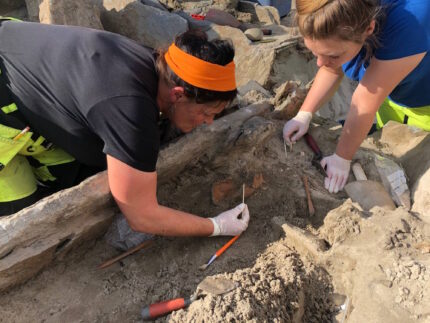 A Neolithic stone cist tomb containing the remains of multiple people has been discovered in Selje, Vestland, western Norway. The style of the tomb and preliminary radiocarbon dating of a fragment of cow skull found there puts the construction of the cist and its earliest burials to around 4,000 years ago. This is the first Neolithic cist tomb found in western Norway, and the first intact one with multiple burials found anywhere in Norway.
A Neolithic stone cist tomb containing the remains of multiple people has been discovered in Selje, Vestland, western Norway. The style of the tomb and preliminary radiocarbon dating of a fragment of cow skull found there puts the construction of the cist and its earliest burials to around 4,000 years ago. This is the first Neolithic cist tomb found in western Norway, and the first intact one with multiple burials found anywhere in Norway.
 Archaeologists from the University Museum in Bergen have been excavating the Seljesanden site since April, in advance of construction of a new hotel. The investigation uncovered remains of prehistoric houses and well-preserved bone middens. In September, a rectangular construction made of stone slabs emerged. Approximately 10 feet long, five feet wide and more than three feet high, the stone cist was formed with standing slabs on the sides and cover slabs forming a ceiling.
Archaeologists from the University Museum in Bergen have been excavating the Seljesanden site since April, in advance of construction of a new hotel. The investigation uncovered remains of prehistoric houses and well-preserved bone middens. In September, a rectangular construction made of stone slabs emerged. Approximately 10 feet long, five feet wide and more than three feet high, the stone cist was formed with standing slabs on the sides and cover slabs forming a ceiling.
 The interior of the tomb is divided into two chambers containing human skeletal remains. So far, archaeologists have unearthed the remains of at least five individuals, including a man around 50-60 years old with arthritis, a young woman and an infant less than one year old. Further radiocarbon dating will illuminate the timeline of the burials, but it’s almost certain that they did not all take place at the same time. The cist was reopened and new bodies placed inside when someone died.
The interior of the tomb is divided into two chambers containing human skeletal remains. So far, archaeologists have unearthed the remains of at least five individuals, including a man around 50-60 years old with arthritis, a young woman and an infant less than one year old. Further radiocarbon dating will illuminate the timeline of the burials, but it’s almost certain that they did not all take place at the same time. The cist was reopened and new bodies placed inside when someone died.
 The bone material is in very good condition thanks to the high proportion of sand in the soil, and researchers hope they will be able to discover the ages, places of origin and possible kinship of the people who were interred in the grave. The layers of animal bones and shells in the midden pile will add detailed information about what they ate.
The bone material is in very good condition thanks to the high proportion of sand in the soil, and researchers hope they will be able to discover the ages, places of origin and possible kinship of the people who were interred in the grave. The layers of animal bones and shells in the midden pile will add detailed information about what they ate.
Hunter-gatherer populations migrated into Norway about 10,000 years ago. Agriculture settlements first began to appear in Oslofjord, southeast Norway, around 5,000 years ago. From there agriculture spread westward, but until now, there has been no archaeological evidence of when it reached western Norway. The discovery of the agricultural settlement and stone cist will shed new light on the people who first farmed western Norway at the dawn of agriculture in the country.